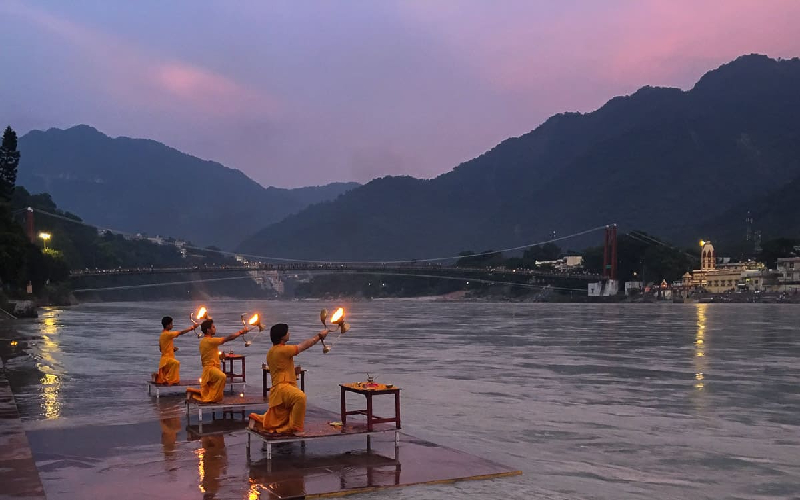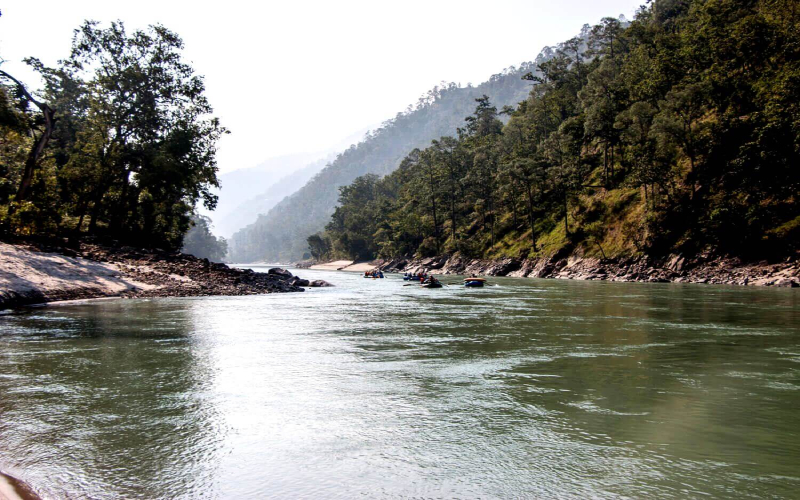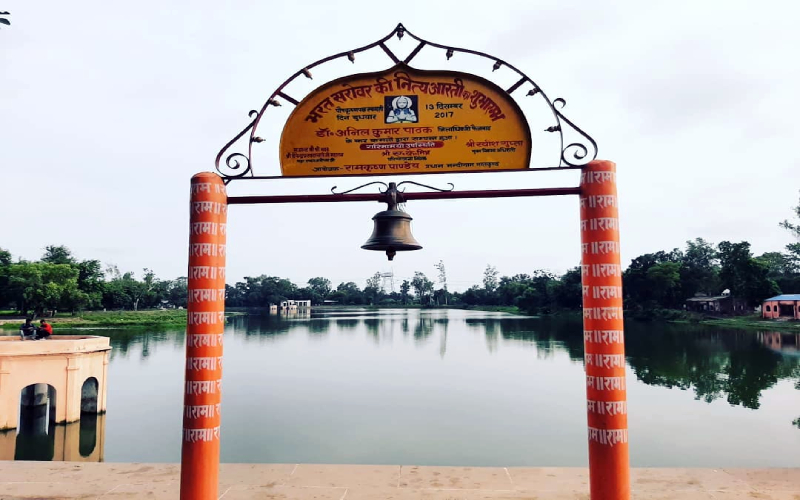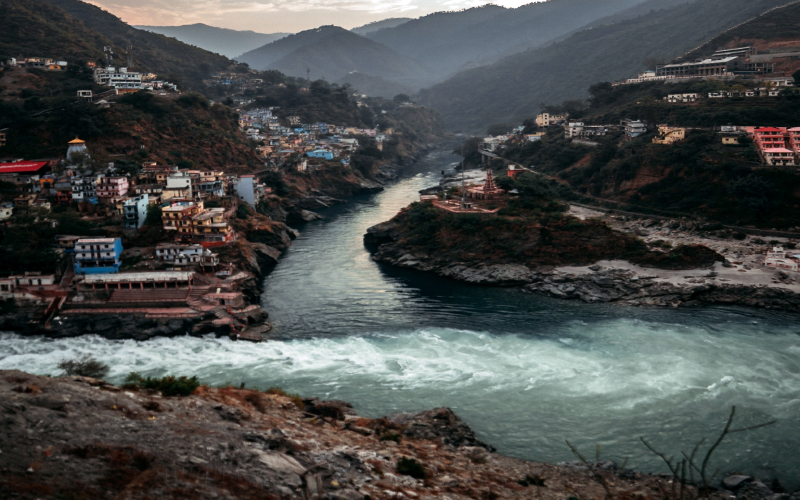
River Ganga is the third largest river in terms of discharge and gushes through 2500 km. The size of the basin is 1.32 million sq. km. Several provisional and imperial capitals are located at the banks of the Ganga, Pataliputra, Kannauj, Kara, Kashi, Patna, Hajipur, Bhagalpur, Munger, Murshidabad, Baharampur, Kampilya and Kolkata. The river is home to more than 140 species of fish and 90 species of amphibians. The Ganga contains a number of reptiles and mammals including the critically endangered ones such as Gharial and the South Asian River dolphin.
The Ganga flows for 260 km in the Himalayan valley and then emerges from the mountains at Rishikesh. Thereafter, it debouches on to the Gangetic plain at Haridwar. Subsequently, it flows another 900 km through a couple of cities and is joined by the Ram Ganga on the way. The Yamuna joins the Ganga at the Triveni Sangam (Prayagraj) and this confluence is considered to be very holy. Interestingly, the Yamuna is larger and contributes 58.5% of the combined flow.

Ganga meets the Tamsa river, Gomti river, Ghaghara River, while on its way. The Ghaghara (Karnali) river is the largest tributary of Ganges by discharge. Rivers Soan, Gandaki and Kosi are the other tributaries. The Kosi is next only to Ghaghara and Yamuna by discharge. Along the way to Prayagraj and Malda in West Bengal, the Ganga passes through the towns of Chunaar, Varanasi, Ballia, Buxar, and Farakka. It is at Bhagalpur that the Ganga begins to flow Southeast and at Farakka it begins its attrition with the branching away of its first distributary, Bhagirathi–Hooghly which goes on to become river Hooghly. The Hooghly has been formed by the confluence of Ajay and Katwa. It has several tributaries including the Damodar river. Finally, Hooghly empties into the Bay of Bengal near Sagar Island, and it passes through towns like Nabadvip and Howrah.
On entering Bangladesh, the main branch of Ganga, known as Padma, is joined by River Jamuna (Largest tributary of Brahmaputra). Finally, the Padma joins River Meghna and the converged flow of Surma-Meghna River System empties itself into the Bay of Bengal. It first enters the Meghna Estuary before entering the ocean and here it forms the 1430 X 3000 km ‘Bengal Fan’ (The world’s largest submarine fan and it accounts for about 10 to 20% of the global burial of organic carbon). Interestingly, the Ganges delta formed by the sediment laden flows of Ganga and Brahmaputra is the world’s largest Delta. It stretches 400 km along the Bay of Bengal and is about 64,000 sq. km.
The Ganges basin ranges from the Himalaya, the Trans-Himalaya in the North to the northern slopes of the Vindya range in the South, to the eastern slopes of Aravalli in the West to the Chota Nagpur plateau and the Sundarbans on the East. The Himalayas which form part of the Ganga basin contained nine of the fourteen highest peaks in the world and all of them measure over 8000 m in altitude.

The Sarayu is one more tributary of the Ganga. It originates in Uttarakhand and flows through Ayodhya. It raises at Sarmool and flows through the Kumaon Himalayas and passes by towns like Bhageshwar before flowing into the Shardha river. This river, Shardha is also known by the names Kali and Mahakali. Sharadha is also another name for Goddess Saraswati. The Sarayu flows into the Shardha at Pancheshwar.
The sacred Sarayu is found in the Epic Ramayana. It is near the Sarayu that we have Nandigram located. Nandigram is also known as Bharatkund. It is from here that Raja Bharata ruled Kosala as a representative of Lord Rama during the period of the exile. Bharata had refused to accept the throne of Ayodhya and went in search of Rama. However, the elder brother refused to budge in and Bharata had to be pacified with just the sandals of Rama. Bharata carrying the sandals on his head to Nandigram, got them coronated. The sandals are known as ‘Paduke’ in Sanskrit and this coronation came to be known as ‘Paduka Pattabhishekam.’
The Paduka-s (Anglicized form) would be carried into the city of Ayodhya regularly on Rama’s elephant, Shatrunjaya. Swami Vedanta Desika has spoken about the glories of the Lord’s Paduka-s in the ‘Padukasahasram’ (Thousand verses on the holy sandals of Lord Ranganatha). He states that Bharata performed Thirumanjanam (Holy bath) to the Paduka-s every morning and this holy water would enter Sarayu thereby making it sacred. It is at the Sarayu that Lord Rama departed to heaven many years before.

The Sarayu containing the Thirumanjanam water in turn joined the river Ganga and therefore the Ganga became more sacred. This great river had emanated from Vishnu Pada and was now joined by Sarayu which carried waters from the Paduka-s of Lord Rama. Therefore, this place can be known as the ‘Paduka Prayag.’ The divine confluence flows further and enters the great ocean. The ocean thus becomes extremely sacred. The people of Bharatavarsha are extremely fortunate because the water which evaporates from the sacred ocean, forms clouds and travels over land to offer a rain of blessings to them. This sprinkling of holy water on the whole country makes the land even more sacred. Thus, the Ganga and the Sarayu add to the divine nature of our country due to their associations with the Vishnu Pada and Rama Paduka-s.

Mr. Rajesh Govindarajulu is one of the founding members of the Verandah Club Pvt. Ltd. He is a leading columnist, historian, jeweler, entrepreneur, and a heritage enthusiast who is earnestly working to revive the past in the light of the present. Experiential learning about the history of Coimbatore is his main course of interest and he is also a panel member of many colleges in the city.
NEXT ARTICLE